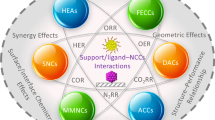Abstract
We analyze the effect of functionalization in the surface of zinc oxide crystal structure by 3-mercaptopropionic acid. X-ray powder diffraction data and extended x-ray absorption fine structure studies confirms a wurtzite structure. However, the morphology of the surface seems to be reduced and shows a film-like surface as demonstrated by x-ray absorption near edge structure and scanning electron microscopy. As a result of surface functionalization, the energy levels of the semiconductor were shifted toward reductive potentials (by 50 mV) as determined by diffuse reflectance and cyclic voltammetry.







Similar content being viewed by others
References
P.R. Brawn, D. Kim, R.R. Lunt, N. Zhao, M.G. Bawendi, J.C. Grossman, and V. Bulović: Energy level modification in lead sulfide quantum dot thin films through ligand exchange. ACS Nano 8, 5863 (2014).
F.W. Wise: Lead salt quantum dots: the limit of strong quantum confinement. Ace. Chem. Res. 33, 773 (2000).
X. Jiang, R.D. Schaller, S.B. Lee, J.M. Pietryga, V.I. Klimov, and A.A. Zakhidov: PbSe nanocrystal/conducting polymer solar cells with an infrared response to 2 micron. J. Mater. Res. 22, 2204 (2007).
J.J. Choi, Y.-F. Lim, M.E.B. Santiago-Berrios, M. Oh, B.-R. Hyun, L. Sun, A.C. Bartnik, A. Goedhart, G.G. Malliaras, H.D. Abruña, F.W. Wise, and T. Hanrath: PbSe nanocrystal excitonic solar cells. Nano Lett. 9, 3749 (2009).
A. Fulati, S. Usman AN, M. Riaz, G. Amin, O. Nur, and M. Willander: Miniaturized pH sensors based on zinc oxide nanotubes/nanorods. Sensors 9, 8911 (2009).
S.K. Hau, H.-L. Yip, N.S. Baek, J. Zou, K. O’Malley and A.K.-Y. Jen: Air-stable inverted flexible polymer solar cells using zinc oxide nanopar-ticles as an electron selective layer. Appl. Phys. Lett. 92, 253301 (2008).
R. Niepelt, U.C. Schröder, J. Sommerfeld, I. Slowik, B. Rudolph, R. Moller, B. Seise, A. Csaki, W. Fritzsche, and C. Ronning: Biofunctionalization of zinc oxide nanowires for DNA sensory applications. Nanoscale Res. Lett. 6, 511 (2011).
B. Zhang, T. Kong, W. Xu, R. Su, Y. Gao, and G. Cheng: Surface function-alization of zinc oxide by carboxyalkylphosphonic acid self-assembled monolayers. Langmuir 26, 4514 (2010).
O. Voznyy, D. Zhitomirsky, P. Stadler, Z. Ning, S. Hoogland, and E.H. Sargent: A charge-orbital balance picture of doping in colloidal quantum dot solids. ACS Nano 6, 8448 (2012).
S. Öztürk, N. Tasaltin, n Kilinç, and Z.Z. Öztürk: Fabrication of ZnO nano- tubes using AAO template and sol-gel method. J. Optoelectron. Biomed. Mater. 1, 15 (2009).
F. Dong, L. Licheng, X. Weilin, L. Guangzhong, L. Zhiping, Z. Yingsan, X. Jie, and X. Chuanxi: Hollow SnO2-ZnO hybrid nanofibers as anode materials for lithium-ion battery. Mater. Res. Express 1, 025012 (2014).
A. Pang, C. Chen, L. Chen, W. Liu, and M. Wei: Flexible dye-sensitized ZnO quantum dots solar cells. RSC Adv. 2, 9565 (2012).
A. Petrella, P. Cosma, M. Lucia Curri, S. Rochira, and A. Agostiano: Colloidal nanocrystal ZnO- and TiO2-modified electrodes sensitized with chlorophyll a and carotenoids: a photoelectrochemical study. JNanopart Res 13, 6467 (2011).
R.N. Lokesh, L. Balakrishnan, K. Jeganathan, S. Layek, H.C. Verma, and N. Gopalakrishnan: Role of surface functionalization in ZnO:Fe nanostructures. Mater. Sci. Eng. B 183, 39 (2014).
D.R. Roberts, R.G. Ford, and D.L. Sparks: Kinetics and mechanisms of Zn complexation on metal oxides using EXAFS spectroscopy. J. Colloid Interface Sci. 263, 364 (2003).
E.-S. Jeong, H.-J. Yu, S.-W. Han, S.J. An, J. Yoo, Y.-J. Kim, and G.-C. Yi: Local structural properties of ZnO nanoparticles, nanorods, and powder studied by extended x-ray absorption fine structure. J. Korean Phys. Soc. 53, 461 (2008).
E.-S. Jeong, H.-J. Yu, Y.-J. Kim, G.-C. Yi, Y.-D. Choi, and S.-W. Han: Local structural and optical properties of ZnO nanoparticles. J. Nanosci. Nanotechnol. 10, 3562 (2010).
J. ES, Y. HJ, S. Han, S. An, J. Yoo, Y. Kim, and G. Yi: Local structural properties of ZnO nanoparticles, nanorods and powder studied by extended x-ray absorption fine structure. J. Korean Phys. Soc. 53, 461 (2008).
B. Ravel, and M. Newville: ATHENA, ARTEMIS, HEPHAESTUS: data analysis for x-ray absorption spectroscopy using IFEFFIT. J. Synchrotron Radiat. 12, 537 (2005).
P.M. Aneesh, K.A. Vanaja, and M.K. Jayaraj: Synthesis of ZnO nanoparticles by hydrothermal method. Proc. SPIE, Nanophotonic Materials IV, 6639, 66390J (2007).
M. Pourbaix: Atlas of Electrochemical Equilibria in Aqueous Solutions (Pergamon Press, Oxford/New York, 1966).
X.G. Zhang: Electrochemistry of Zinc Oxide, in Corrosion and Electrochemistry of Zinc, (Springer, Boston, 1996), p. 93.
Y. Liu, M.S. Liu, and A.K.-Y. Jen: Synthesis and characterization of a novel and highly efficient light-emitting polymer. Acta Polym. 50, 105 (1999).
L. de la Cueva, K. Lauwaet, R. Otero, J.M. Gallego, C. Alonso, and B.H. Juarez: Effect of chloride ligands on CdSe nanocrystals by cyclic voltammetry and x-ray photoelectron spectroscopy. J. Phys. Chem. C 118, 4998 (2014).
D. Liu, W. Wu, Y. Qiu, S. Yang, S. Xiao, Q.-Q. Wang, L. Ding, and J. Wang: Surface functionalization of ZnO nanotetrapods with photoactive and electroactive organic monolayers. Langmuir 24, 5052 (2008).
Acknowledgments
The authors want to thank Dr. Victor M. Rodriguez from Universidad Metropolitana, Kenneth David Finkelstein, and Matthew James Ward from CHESS and Dr. Carlos R. Cabrera from the University of Puerto Rico for constructive discussion during the preparation of this manuscript. Financial support was possible due to PR REU: Research training in cross-disciplinary chemical sciences. NSF CHE 1262826.
Author information
Authors and Affiliations
Supplementary material
Supplementary material
The supplementary material for this article can be found at http://dx.doi.org/10.1557/mrc.2016.14.
Rights and permissions
About this article
Cite this article
de los Cepeda-Perez, M.A., Reyes-Marte, C.M., Carrasquillo, V.A. et al. Effect of the ligand in the crystal structure of zinc oxide: an x-ray powder diffraction, x-ray absorption near-edge structure, and an extended x-ray absorption fine structure study. MRS Communications 6, 93–97 (2016). https://doi.org/10.1557/mrc.2016.14
Received:
Accepted:
Published:
Issue Date:
DOI: https://doi.org/10.1557/mrc.2016.14




